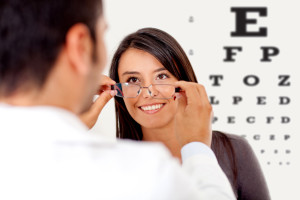
Your body is a machine. Over time, machine parts can wear down and need tended to. Your eyes work every day focusing and re-focusing. This can cause wear and tear over the course of many years. The eye muscle is a smooth muscle, so unlike the muscles in your arms, exercising it daily wears it down instead of building it up. Listed below are some common problems and disorders of aging eyes.
Presbyopia is a common occurrence in individuals over the age of 40 years and aging eyes. This refers to the difficulty in focusing on objects close to you. One day you may notice that it is hard to read the menu at a restaurant. Or, your phone looks a bit fuzzy when you try to read a text. This is the sign of presbyopia. Corrective contacts and eyeglasses are common ways to cope with this blurry vision.
Age-Related Macular Degeneration (ARMD) affects millions of elderly people in the United States. This is a disease of the central part of the retina. The macula is the part of the eye which creates a sharp central focus. When the disease wears this part of the eye down over time, central vision loss is the result. This can affect the individual’s daily life tasks such as driving. Unfortunately, there is no cure. The best prevention to ARMD is to keep a healthy diet, do not smoke, and wear sunglasses to prevent exposure UVA/UVB rays.
Cataracts are known to be a disease of the eye that afflicts the aging. Cataracts affect the lens of the eyes. A cloudy film forms on the lens, making it difficult for light to get through to form the “picture” needed. Cataracts form over time and can cover part or all of the lens. Surgery can correct this disease in the majority of patients.
Glaucoma is another disease of the eye that is common as we age. Fluid builds up within the eye and can be the cause of vision loss. Pain and indications of glaucoma are not normally present, so regular eye health checks with your optometrist are important to catch this eye-aging disease early.
Floaters are small, harmless specks that “float” across your eyes. They are not painful and are fairly normal. Floaters, however, can be a sign of a more serious condition called Retinal Detachment (RD). RD occurs when the retina detaches and, if not treated immediately, can cause permanent loss of vision in the affected eye. Signs that you have RD are a sudden flash of light, the feeling of a curtain being pulled over your vision, or even a bunch of new floaters. If any of these occur, visit your eye care health professional immediately.
Tearing can occur in anyone of any age due to wind, heat, dry eye condition, etc. But, the older you get the more likely you are to have tearing due to your aging eyes. It is found that women tend to have this condition due to aging eyes more often than men. Environmental reasons are not always the culprit. Tearing can also be a sign that you have a blocked tear duct. Your doctor can prescribe moisturizing eye drops to help prevent your eyes from tearing too often.
While aging is not preventable, the maintenance of your body, the “machine”, is essential to keeping your parts and pieces working at its best. Regular eye exams and communicating with your optometrist are the keys to good eye health. Find a physician near you at IPALC.org
Share on Facebook



 Southwest Florida Medicine.com is dedicated to bringing you the very best health information available today!
Subscribe or check back regularly!
Southwest Florida Medicine.com is dedicated to bringing you the very best health information available today!
Subscribe or check back regularly!